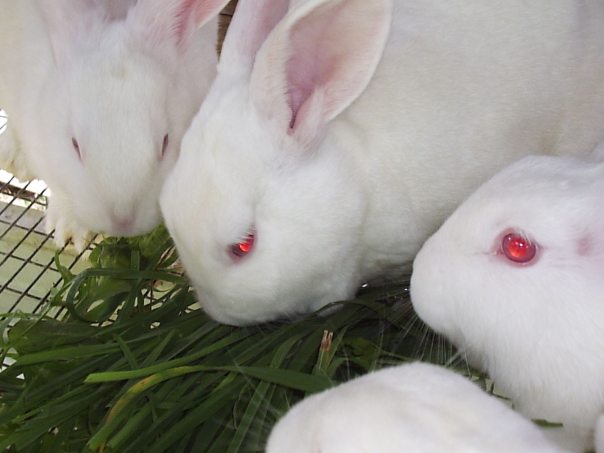WORMS AND RABBITS TOGETHER
When raising rabbits if you have a few cages or a large rabbitry you can raise, grow, and harvest worms and compost under your rabbit cages or hutches. Raising worms under your hutches this will help control the smells and insects that can be a problem with the acculmated waste under the cages and hutches. The worms will reuse the rabbit manure and wasted feed from the hutches and turn it into a dark, nutrient-rich, finely-textured humus
Raising rabbits and worms together works so well because the nutrients in rabbit droppings and the wasted rabbit food and hay contains the perfect mix as a food source and as a bedding for the worms. You can also raise the worms in compost bins or vermicomposting bins using the rabbit manure as a top dressing, for worm feed, and also as a worm bedding. Keeping worms under the rabbit cages also allows you to raise worms for fishing bait, chicken food, vermicomposting and this adds another bartering item you have on your homestead. This helps you to produce another potential source of income from your homestead and also improving your sustainability and another great fertilizer for your gardens.
Growing worms with rabbits is easy, I am in no way a worm expert. This post is what works for me in my rabbitry. I have found that the best kind of worm to use under rabbit cages is the red worm or Eisenia fetida. They are also known as brandling worms, manure worms, tiger worms, panfish worms, trout worms and many other names. But whatever you call them, they are the best choice of worm for under your cages and for composting.
I started by building my worm beds underneath my existing rabbit hutches back in the early 80s. I dug a trench under the hutches extending 6 inches out from the cages on all sides. Digging the trench about 12 inches deep to make my beds. This worked fine and I raised MANY worms for fishing bait using the trench system.
The rabbit cages should be at least three feet above the worm beds. I have also constructed beds under hutches and cages from 1x12s or 2x12s and putting them on their sides and screwing together to make a raised worm bed under the hutches. This can be built very inexpensively as the wood frame can be made from scrap lumber or pallets. Just try to make the worm bed about 12 inches deep. Remember to make the worm bed itself about four to six inches wider than the hutch or cage area to catch all the rabbit droppings, urine, and wasted feed. You can use the pit or trench system as mentioned earlier. It is best if you can add a base layer of sand or gravel for drainage this is weather you are using either the trench or raised bed method.
Placing 5 to 6 inches of bedding material in the bottom of the worm bed is sufficient for starting the worms. I use a mix of carbon type materials such as shredded paper or cardboard, leaves, hay, straw, and peat moss. Most worm growers prefer peat but I like what I can get around the homestead for free. I have found that the worms will general only use the top 6 inches of bedding unless certain circumstance’s make them go deeper, such as cold weather.
Moisten the bedding with water and let your rabbits do their thing until the surface is covered with 1 to 2 inches layer of rabbit manure. Mix the rabbit manure and bedding material together and wet it down. Rabbit manure is considered a cold manure, but by mixing the carbon and nitrogen materials it will generate some heat due to the natural composting processes, so keep mixing the bedding and lightly water it once a day for about 2 to 3 days.
On the third day, do the hand test by putting your hand into the bed to feel for heat. If the bedding material is hot, keep mixing it once a day until the heat is out of the bedding, Make shure it is cooled before you begin adding your worms into the beds. When the bedding is cool to the touch, you can add your worms. They should disappear immediately into the moist bedding material.
When starting the worm beds you should begin with 200 to 300 red worms per square foot of surface area. You can add less worms, but they will not work as effectively at turning the manure into compost. But they will reproduce, and soon you will have pleanty.
If you are raising the worms to sell, do not use more than 200 worms per square foot to allow the worms enough nutrients, room, and food to grow large. People will be lining up for you large trout catching worms!
Worms cannot eat dry, rabbit manure, you will need to maintain a moisture level so the bedding is just damp enough to squeeze out a drop or two of water when you squeeze it. Sprinkling the beds with water a few times a week will help to keep the bedding moist, but remember to skip by the areas under the automatic drinking valves, water bottles, or water crocks as they are usually already wet enough. In the summer time, you may have to water once or twice a day if the top of the worm beds dries too fast.
To maintain the worm beds you should add an additional inch of leaves, straw, or hay a few times each month and mix the beds with a pitchfork from top to bottom to avoid packed bedding. I will remove the urine spots from the worm pile with a shovel about once a week. This prevents the beds from getting too salty and hot for the worms. I add this urine soaked bedding to my compost piles. Leaving the urine spots in the worm bed eventually leads to a bad odor and insect problems.
After about six months you can start harvesting worms and saving the great fertilizer your rabbits and worms have made. I do this about once a year, I will remove half of the bed, save some worms and add the rest to my gardens. Then add new bedding just as you did when starting a new bed. Over the next few weeks the worms will move to the new bedding, and the old compost can be removed and sold, bartered, spread over a garden, or set aside to use later.
Do not harvest any worms for at least a few days after harvesting, and be sure to check the temperature and moisture conditions the following day. If the material is too dry or is heating up, water and mix again for the next few days.
If you plan to use your worm castings as a soil amendment, make sure that the castings are kept slightly moist and protected from sun and bad weather when storing. Poor handling, such as storing in areas leached by rainwater, will result in a loss of the nutrients.
THE RED WORMS LIFE CYCLE
Red worms are hermaphrodites meaning that each worm is both male and female. It still takes two worms to mate as they can not reproduce on their own. When a red worm is sexually mature you will see the bulbous gland around its segments this is called the clitellum it looks like a swollen band about a third of the way down the body. It takes 3 months for a newly-hatched red wriggler to attain sexual maturity. Adult red wigglers secrete a number of egg cocoons after mating, and after an incubation period of about 21 days, between 4 and 6 juvenile worms hatch from each cocoon. The cocoon is a small yellowish grain almost looking like a grain of rice. As soon as they are hatched the worms are ready to start their diet of rabbit poop. The hatched worms first appear as a tiny thread like white worm. After about 8 hours they start to gain their hemoglobin and change to a pale pink then turning to a brick red color. It takes up to four months for a healthy and well-fed red wiggler population to double in number.
VERMICOMPOSTING
Vermicomposting is the process of using worms to convert organic matter to compost. This process is as old as time. This is happening in the forests and pastures every day naturally. By using worms under your hutches you are creating a controlled system of vermicomposting and you can harvest the worms for bins and the awesome worm castings.
One of the greatest pioneers in vermicomposting was a Michigan biology teacher Mary Appelhof who started the idea of home vermicomposting. In 1972, she realized she wanted to continue composting in the winter months despite living in a northern climate, she started with 1 pound of red wiggler worms, or Eisenia fetida, from a bait dealer. She created a shallow bin in her basement, loaded it with bedding and added her food scraps. By the end of the winter, they had consumed 65 lbs. of garbage and produced worm compost that resulted in impressive vegetables in her garden. Her book “Worms Eat My Garbage” Is a must have book for the homestead library! This is a great way to continue your soil production through the winter months. I have a few bins in my basement for holding my worms and composting in the winter, this is my added insurance in case all my outside beds die off in the winter.
WORMS AS CHICKEN FOOD
I have mentioned using your worms as fish bait and vermicomposting, But remember your chickens LOVE worms! It gives them a great protein intake. I sometime have problem’s with my Silkies digging up the beds and eating lots of my worms . You can harvest a few worms and toss them inside the coops or runs for them to eat off the ground, or put them in bowls. But there’s also a better way to feed worms to chickens. You can choose to dry them, and then grind or crumble them. You can dry worms by placing them under an electric light bulb, in a oven, or inside a greenhouse. When they’re dry they are ready to be crushed or ground up, you can then add the crushed worm pieces as an additive to your usual chicken food supply. By drying the worms they are easier to save as a winter food source. Red Worms as a organic chicken feed can be a good idea for you to promote on your homestead. Even to sell and saving you money on chicken feed. Worm is about 80% protein.
If I have missed anything or you have questions, please leave some comments. I update my post all the time when I get new ideas or information. Join the Rabbit Revolution! By subscribing to my site and checking us out on Facebook







